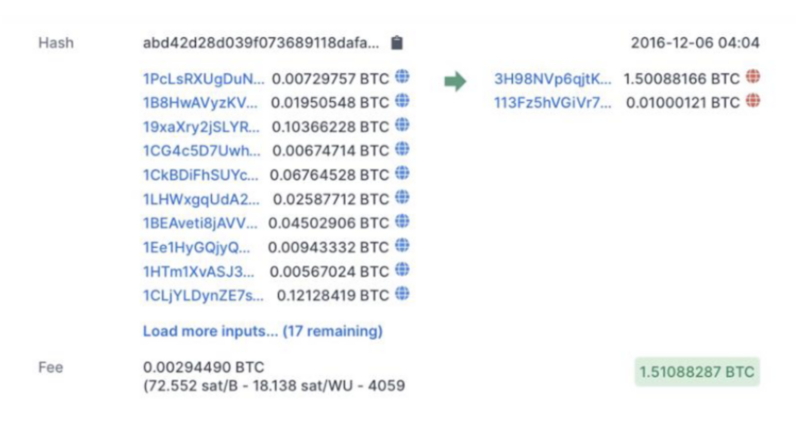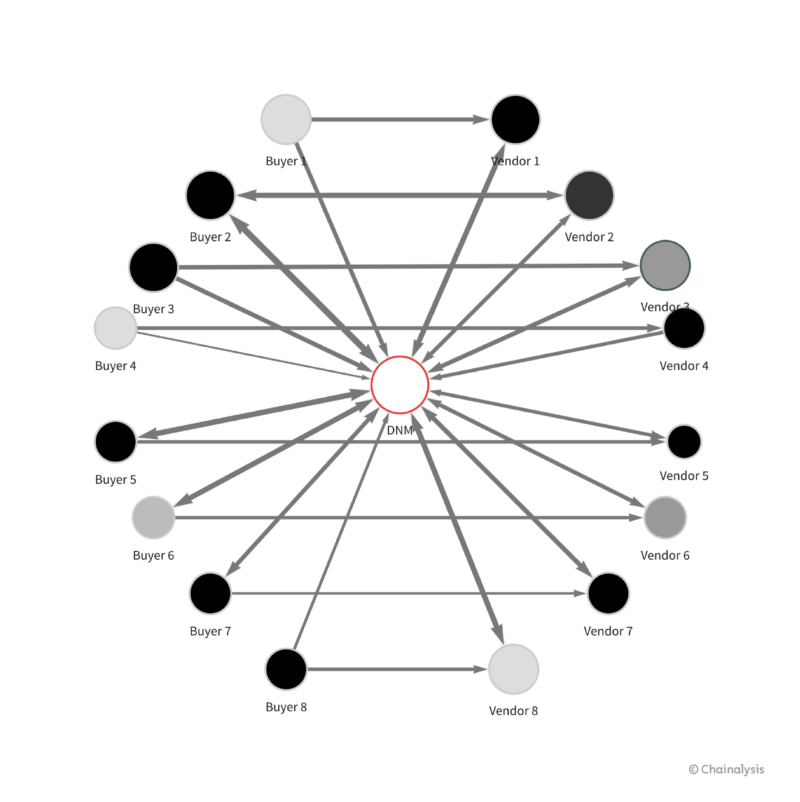News
Blockchain Intelligence to Investigate Crypto Crime

With a global market capitalization exceeding $2 trillion, regulation increasing worldwide, and adoption growing each year, cryptocurrency is here to stay. What does this mean for law enforcement?
It’s no surprise that where economic opportunity abounds, so do attempts to subvert it with crime. Much like fiat currency, crypto has been used in connection with scams, ransomware, money laundering, child exploitation, terrorist financing, sanctions evasion, and darknet market commerce. In 2023, $24.2 billion of total crypto transaction volume was tied to illicit activity. While this is a large figure, without context, it doesn’t quantify the human toll of crypto-based crime.
For example, one insidious crime with a crypto nexus — “pig butchering” — is a unique social engineering scam in which scammers build trust with victims via social media apps and text messages, and trick them into investing their money on fake platforms. The impact of these scams has been devastating, with some victims losing pensions and lifetime savings, along with their peace of mind and confidence.
Pig butchering scams are just one example of how criminals have been adapting their tactics with increasing sophistication in the last few years. Now more than ever, law enforcement must be equipped with the knowledge and capabilities to combat crypto crime. This blog post will discuss how criminals are using crypto and why, and how law enforcement agencies both large and small leverage blockchain intelligence to investigate crypto-based crime.
How crypto and crime intersect
Cryptocurrencies have criminal relevance due to their versatility as both a means of payment and an investment vehicle, and are appreciated for their pseudonymity. Cryptocurrency is often employed in darknet trading, ransomware attacks, forms of hacking like cryptojacking — in which criminals secretly use victims’ computing power to mine crypto — and money laundering. In 2023, over $22 billion in crypto worldwide was used for that purpose. Crypto is also used in various types of fraud, and has been associated with theft via hacking incidents, as well as facilitating CSAM (child sexual abuse material), sanctions evasion, terrorist financing, and commercial offenses (e.g., weapons dealing, counterfeiting money, forged documents, and the sale of narcotics and medicine).
Here are some of crypto’s attributes and capabilities that make it desirable for criminal use:
- Pseudonymity: Some criminals mistakenly perceive crypto as anonymous, when it’s actually pseudonymous because crypto exchanges are required to maintain customer information in order to comply with know your customer (KYC) and anti-money laundering (AML) regulations. Still, a crypto transaction on a blockchain ledger is only initially identifiable by a public address, and finding the person or entity who controls that address takes some footwork.
- Speed, cost, and ease of use: Crypto transactions, including those made across borders, are faster and far less expensive than a standard wire transfer, in addition to being pseudonymous.
- Deception tactics: Criminals attempting to launder funds are often drawn to crypto mixers, services that obfuscate the origin and destination of crypto transactions.
- Potential return on investment: Again, crypto poses an attractive investment opportunity for some criminals, especially since it’s not tied to traditional financial markets.
Leveraging blockchain intelligence to investigate crypto crime
While the blockchain is transparent, it’s hard to read. Consider also, that the Bitcoin blockchain alone has processed nearly one billion transactions. When it comes to efficiently and effectively investigating crypto crime, blockchain intelligence provides a game-changing advantage for law enforcement as it offers the ability to analyze extensive on-chain datasets, graphing capabilities to organize that data, and contextualized insight into illicit crypto activity. By contrast, anyone can search for crypto transactions using a block explorer, but those tools don’t aggregate data in actionable ways.

The image above shows a single transaction as displayed on a block explorer. That data shown above may be public, but it’s not very insightful; it begs more questions than it answers. For example:
- Who are the pseudonymous entities? Are they cryptocurrency exchanges, merchant processors, or darknet markets?
- Why are they transacting? Is it a payment, an investment, or a smart contract?
- How much value are they transacting? Is it hundreds, thousands, or millions of dollars worth of cryptocurrency?
Blockchain intelligence helps organizations answer these questions. Using it, law enforcement agencies identify criminal entities by examining on-chain activity like the movement of stolen or laundered crypto. The teams that support this technology cultivate extensive on-chain datasets and offer graphing capabilities that help law enforcement visually trace the flow of funds over time, and connect crypto transactions to real-world entities. These platforms also provide contextual information that facilitates a greater understanding of illicit on-chain activity. The Chainalysis graph below displays multiple, contextualized crypto transactions and the entities that initiated them.

Blockchain intelligence helps investigators map crypto transactions and present them in an easily digestible format. For example, the graph above shows the transaction relationships between eight drug buyers and vendors, each of which have ties to the same darknet market. Blockchain intelligence helps law enforcement progress investigations, apprehend criminals, present cases for prosecution, and prepare the way for the seizure and recovery of crypto funds to victims when possible.
In the course of an investigation, blockchain intelligence also facilitates faster and more effective collaboration between law enforcement departments as well as government agencies. Using the same dataset contributes to a shared understanding, which drives better investigative outcomes. And while blockchain intelligence is useful for fighting crime, it can also help law enforcement be proactive in preventing crime, too. It’s possible to detect illicit activity early on by analyzing on-chain transaction patterns and relationships that could be indicative of criminal behavior. Here are some examples:
- Observing an unusual increase in transaction volumes or patterns commonly associated with money laundering or fraud
- Disrupting criminal networks by mapping the financial flows of criminal organizations, which could hinder their operations and prevent future crime
- Targeting darknet marketplaces. Proactive transaction monitoring linked to known darknet markets allows law enforcement to gather intelligence on buyers and sellers, identify emerging threats, and take action before illicit transactions escalate.
A holistic approach to tackling crypto crime
1. Prepare: Building a foundation for crypto crime response
For local governments wanting to tackle crypto crime investigations, establishing a comprehensive knowledge base across all teams and departments is critical. This shared understanding enables seamless collaboration and communication throughout an organization and across agencies, from field officers to judges.
In building a foundation to begin fighting crypto crime, leadership support for these initiatives is crucial, necessitating a commitment to capacity building and ongoing training to keep abreast of trends and develop effective policy-making, regulation, and operational strategies.
Building a community of dedicated experts is essential, too. Erin West, Deputy District Attorney for Santa Clara County, who has extensive experience with pig butchering cases says, “you need a lot of partners. This is not something that one investigator can do by themself. You need private partners, you need public partners, you need local law enforcement. You need federal law enforcement, and the idea of putting together task forces, smaller task forces nationwide, I think is a great way to tackle this.”
2. Prevent: Identifying and disrupting crypto crimes
Recognizing the use of cryptocurrency in criminal activities can be pivotal to modern investigative techniques. Agencies must enhance their ability to detect and understand crypto-related activities crucial for uncovering illicit patterns, analyzing the flow of these funds, and supporting broader blockchain investigations or policy-making. Staying informed about criminals’ evolving tactics, such as asset laundering, requires the latest technological and investigative methods.
Understanding the leverage points of crypto in criminal activities — including on/off ramps and digital wallets like CashApp — and tracing these elements through tools like government databases is essential for effective crime prevention. Disrupting crypto crime hinges on continuously updated, reliable data, and law enforcement must have access to current, accurate information.
3. Pursue: Actively chasing down offenders and recovering illicit gains
Law enforcement agencies are encountering crypto in their investigations more frequently. When these assets are discovered, they should be seized and stored until they can be investigated, and ultimately, sold for fiat money.
When it comes to stolen funds, crypto is more recoverable than many law enforcement agencies might think. Partnerships with district attorney’s offices are vital, as they place a significant role in deciding which cases to pursue towards recovering stolen funds.
Recovering crypto funds through seizure is also a technical process that demands proficiency in using seed phrases to gain access to a wallet, and conducting manual verifications to link associated wallets and assess balances. Simply put, identifying the opportunity to seize assets is complex, and the stakes have never been higher. This underscores the necessity for specialized skills and frontline training in identifying and handling critical crypto evidence, as crypto artifacts can often be discovered during search of cars, devices, premises, or when making arrests.
The U.K.’s Metropolitan Police significant Bitcoin seizure of over £2 billion in March 2024 exemplifies the potential success of these operations. This event, along with notable seizures from the past few years, underscores the global scale of the challenge and critical impact of skilled interventions.
| Hezbollah and Iran Quds Force seizure, June 2023: In the first Hezbollah-related digital currency seizure, Israeli authorities recovered roughly $1.7 million in crypto from Hezbollah, a heavily sanctioned terrorist group based in Lebanon, and from Iran’s Quds Force, which funds and works extensively with Hezbollah. Learn more.
Chipmixer seizure, March 2023: Supported by Europol, a group of international authorities seized over €40 million from this unlicensed cryptocurrency mixer. Learn more. Bitzlato seizure, January 2023: Europol seized over $19 million in crypto after the exchange’s founder was charged with money laundering. Learn more. North Korean-linked hacker seizure, September 2022: The U.S. government seized more than $30 million in crypto stolen by North Korean-linked hackers in the Axie Infinity case, marking the first time ever that crypto stolen by a North Korean hacking group was seized. Learn more. Silk Road seizure, November 2021: In one of the largest crypto seizures in history, IRS Criminal Investigations (IRS-CI) seized $3.36 billion in Bitcoin from darknet market Silk Road hacker James Zhong. Learn more. Silk Road seizure, November 2020: The U.S. Department of Justice (DOJ) seized more than $1 billion in Bitcoin from cryptocurrency wallets with connections to the darknet market Silk Road. Learn more. |
4. Protect: United front against crypto crime
Ultimately, successfully combating crypto crime requires a unified effort from government institutions, law enforcement, and legislators. They play an essential role in developing, implementing, and enforcing crypto policies and regulations related to cryptocurrencies and blockchain technology. This united approach is key to creating a secure yet innovative environment that keeps pace with the rapid developments of digital assets and blockchain technology.
Central to law enforcement’s arsenal against crypto crime is the sharing of blockchain intelligence across agencies. Such inter-agency collaboration, coupled with strategic public-private partnerships, strengthens regulatory frameworks and enhances compliance monitoring, thus playing an important role in crime deterrence and prevention.
Much like traditional financial investigations are a routine law enforcement responsibility, cryptocurrency investigations will need to become the same. By utilizing blockchain intelligence, government agencies can actively monitor crypto transactions. This proactive monitoring can aid crime prevention and ensure agencies are ready to respond to significant events in the financial ecosystem — like the sanctioning of major entities or the collapse of a blockchain — that could affect financial stability or pose systemic risks.
Adopting this proactive approach, backed by robust regulatory oversight, is crucial for upholding the integrity and safety of the crypto ecosystem. It highlights the importance of regulation and law enforcement in protecting against the threats posed by crypto-enabled crimes.
Gain a strategic advantage in fighting crypto crime
Over the years, we’ve seen many law enforcement agencies run successful crypto crime investigations using blockchain intelligence — everything from disrupting national security threats to protecting local communities from fraud. Blockchain intelligence plays a critical role in combating these crimes. With the increasing regulation of cryptocurrencies by governments and the continued growth in digital currency adoption, the imperative to address crypto-enabled criminal activities will only intensify. Learn how you can gain a strategic advantage in your efforts against crypto crime with blockchain intelligence.
News
Terra Can’t Catch a Break as Blockchain Gets $6 Million Exploited

The attack, which exploited a vulnerability disclosed in April, drained around 60 million ASTRO tokens, sending the price plummeting.
The Terra blockchain has been exploited for over $6 million, forcing developers to take a momentary break the chain.
Beosin Cyber Security Company reported that the protocol lost 60 million ASTRO tokens, 3.5 million USDC, 500,000 USDT, and 2.7 BTC or $180,000.
Terra developers paused the chain on Wednesday morning to apply an emergency patch that would address the attack. Moments later, a 67% majority of validators upgraded their nodes and resumed block production.
The ASTRO token has plunged as much as 75%. It is now trading at $0.03, a 25% decline on the day. Traders who took advantage of the drop are now on 195%.
The vulnerability that took down the Cosmos-based blockchain was disclosed in April and involved the deployment of a malicious CosmWasm contract. It opened the door to attacks via what is called an “ibc-hooks callback timeout reentrancy vulnerability,” which is used to invoke contracts and enable cross-chain swaps.
Terra 2.0 also suffered a massive drop in total value locked (TVL) in April, shortly after the vulnerability was discovered. It plunged 80% to $6 million from $30 million in TVL and has since lost nearly half of that value, currently sitting at $3.9 million.
The current Earth chain emerged from the rubble as a hard fork after the original blockchain, now called Terra Classic, collapsed in 2022. Terra collapsed after its algorithmic stablecoin (UST) lost its peg, causing a run on deposits. More than $50 billion of UST’s market cap was wiped out in a matter of days.
Terraform Labs, the company behind the blockchain, has been slowly unravelling its legal woes since its mid-2022 crash. Founder Do Kwon awaits sentencing in Montenegro after he and his company were found liable for $40 billion in customer funds in early April.
On June 12, Terraform Labs settled with the SEC for $4.4 billion, for which the company will pay about $3.59 billion plus interest and a $420 million penalty. Meanwhile, Kwon will pay $204.3 million, including $110 million in restitution, interest and an $80 million penalty, a court filing showed.
News
Google and Coinbase Veterans Raise $5M to Build Icebreaker, Blockchain’s Answer to LinkedIn

Icebreaker: Think LinkedIn but on a Blockchain—announced Wednesday that it has secured $5 million in seed funding. CoinFund led the round, with participation from Accomplice, Anagram, and Legion Capital, among others.
The company, which is valued at $21 million, aims to become the world’s first open-source network for professional connections. Its co-founders, Dan Stone and Jack Dillé, come from Google AND Monetary base; Stone was a product manager at the cryptocurrency giant and also the co-creator of Google’s largest multi-identity measurement and marketing platform, while Dillé was a design manager for Google Working area.

The pair founded Icebreaker on the shared belief that the imprint of one’s digital identity (and reputation) should not be owned by a single entity, but rather publicly owned and accessible to all. Frustrated that platforms like LinkedIn To limit how we leverage our connections, Dillé told Fortune he hopes to remove paywalls and credits, which “force us to pay just to browse our network.” Using blockchain technology, Icebreaker lets users transfer their existing professional profile and network into a single, verified channel.
“Imagine clicking the login button and then seeing your entire network on LinkedIn, ChirpingFarcaster and email? Imagine how many introductions could be routed more effectively if you could see the full picture of how you’re connected to someone,” Stone told Fortune.
Users can instantly prove their credentials and provide verifiable endorsements for people in their network. The idea is to create an “open graph of reputation and identity,” according to the founders. They hope to challenge LinkedIn’s closed network that “secures data,” freeing users to search for candidates and opportunities wherever they are online. By building on-chain, the founders note, they will create a public ledger of shared context and trust.
Verified channels are now launched for
Chirping
Online Guide
Wallet
Discord
Telephone
TeleporterYou can find them in Account -> Linked Accounts Italian: https://t.co/mRDyuWW8O2
— Icebreaker (@icebreaker_xyz) April 3, 2024
“Digital networking is increasingly saturated with noise and AI-driven fake personas,” the founders said in a statement. For example: Dillé’s LinkedIn headline reads “CEO of Google,” a small piece of digital performance art to draw attention to unverifiable information on Web2 social networks that can leave both candidates and recruiters vulnerable to false claims.
“Icebreaker was created to enable professionals to seamlessly tap into their existing profiles and networks to surface exceptional people and opportunities, using recent advances in cryptographically verifiable identity,” the company said, adding that the new funding will go towards expanding its team and developing products.
“One of the next significant use cases for cryptocurrency is the development of fundamental social graphs for applications to leverage… We are proud to support Dan, Jack and their team in their mission to bring true professional identity ownership to everyone online,” said CoinFund CIO Alex Felix in a statement.
Learn more about all things cryptocurrency with short, easy-to-read flashcards. Click here to Fortune’s Crash Course in Cryptocurrency.
Fuente
News
Luxembourg proposes updates to blockchain laws | Insights and resources

On July 24, 2024, the Ministry of Finance proposed Blockchain Bill IVwhich will provide greater flexibility and legal certainty for issuers using Distributed Ledger Technology (DLT). The bill will update three of Luxembourg’s financial laws, the Law of 6 April 2013 on dematerialised securitiesTHE Law of 5 April 1993 on the financial sector and the Law of 23 December 1998 establishing a financial sector supervisory commissionThis bill includes the additional option of a supervisory agent role and the inclusion of equity securities in dematerialized form.
DLT and Luxembourg
DLT is increasingly used in the financial and fund management sector in Luxembourg, offering numerous benefits and transforming various aspects of the industry.
Here are some examples:
- Digital Bonds: Luxembourg has seen multiple digital bond issuances via DLT. For example, the European Investment Bank has issued bonds that are registered, transferred and stored via DLT processes. These bonds are governed by Luxembourg law and registered on proprietary DLT platforms.
- Fund Administration: DLT can streamline fund administration processes, offering new opportunities and efficiencies for intermediaries, and can do the following:
- Automate capital calls and distributions using smart contracts,
- Simplify audits and ensure reporting accuracy through transparent and immutable transaction records.
- Warranty Management: Luxembourg-based DLT platforms allow clients to swap ownership of baskets of securities between different collateral pools at precise times.
- Tokenization: DLT is used to tokenize various assets, including real estate and luxury goods, by representing them in a tokenized and fractionalized format on the blockchain. This process can improve the liquidity and accessibility of traditionally illiquid assets.
- Tokenization of investment funds: DLT is being explored for the tokenization of investment funds, which can streamline the supply chain, reduce costs, and enable faster transactions. DLT can automate various elements of the supply chain, reducing the need for reconciliations between entities such as custodians, administrators, and investment managers.
- Issuance, settlement and payment platforms:Market participants are developing trusted networks using DLT technology to serve as a single source of shared truth among participants in financial instrument investment ecosystems.
- Legal framework: Luxembourg has adapted its legal framework to accommodate DLT, recognising the validity and enforceability of DLT-based financial instruments. This includes the following:
- Allow the use of DLT for the issuance of dematerialized securities,
- Recognize DLT for the circulation of securities,
- Enabling financial collateral arrangements on DLT financial instruments.
- Regulatory compliance: DLT can improve transparency in fund share ownership and regulatory compliance, providing fund managers with new opportunities for liquidity management and operational efficiency.
- Financial inclusion: By leveraging DLT, Luxembourg aims to promote greater financial inclusion and participation, potentially creating a more diverse and resilient financial system.
- Governance and ethics:The implementation of DLT can promote higher standards of governance and ethics, contributing to a more sustainable and responsible financial sector.
Luxembourg’s approach to DLT in finance and fund management is characterised by a principle of technology neutrality, recognising that innovative processes and technologies can contribute to improving financial services. This is exemplified by its commitment to creating a compatible legal and regulatory framework.
Short story
Luxembourg has already enacted three major blockchain-related laws, often referred to as Blockchain I, II and III.
Blockchain Law I (2019): This law, passed on March 1, 2019, was one of the first in the EU to recognize blockchain as equivalent to traditional transactions. It allowed the use of DLT for account registration, transfer, and materialization of securities.
Blockchain Law II (2021): Enacted on 22 January 2021, this law strengthened the Luxembourg legal framework on dematerialised securities. It recognised the possibility of using secure electronic registration mechanisms to issue such securities and expanded access for all credit institutions and investment firms.
Blockchain Act III (2023): Also known as Bill 8055, this is the most recent law in the blockchain field and was passed on March 14, 2023. This law has integrated the Luxembourg DLT framework in the following way:
- Update of the Act of 5 August 2005 on provisions relating to financial collateral to enable the use of electronic DLT as collateral on financial instruments registered in securities accounts,
- Implementation of EU Regulation 2022/858 on a pilot scheme for DLT-based market infrastructures (DLT Pilot Regulation),
- Redefining the notion of financial instruments in Law of 5 April 1993 on the financial sector and the Law of 30 May 2018 on financial instruments markets to align with the corresponding European regulations, including MiFID.
The Blockchain III Act strengthened the collateral rules for digital assets and aimed to increase legal certainty by allowing securities accounts on DLT to be pledged, while maintaining the efficient system of the 2005 Act on Financial Collateral Arrangements.
With the Blockchain IV bill, Luxembourg will build on the foundations laid by previous Blockchain laws and aims to consolidate Luxembourg’s position as a leading hub for financial innovation in Europe.
Blockchain Bill IV
The key provisions of the Blockchain IV bill include the following:
- Expanded scope: The bill expands the Luxembourg DLT legal framework to include equity securities in addition to debt securities. This expansion will allow the fund industry and transfer agents to use DLT to manage registers of shares and units, as well as to process fund shares.
- New role of the control agent: The bill introduces the role of a control agent as an alternative to the central account custodian for the issuance of dematerialised securities via DLT. This control agent can be an EU investment firm or a credit institution chosen by the issuer. This new role does not replace the current central account custodian, but, like all other roles, it must be notified to the Commission de Surveillance du Secteur Financier (CSSF), which is designated as the competent supervisory authority. The notification must be submitted two months after the control agent starts its activities.
- Responsibilities of the control agent: The control agent will manage the securities issuance account, verify the consistency between the securities issued and those registered on the DLT network, and supervise the chain of custody of the securities at the account holder and investor level.
- Simplified payment processesThe bill allows issuers to meet payment obligations under securities (such as interest, dividends or repayments) as soon as they have paid the relevant amounts to the paying agent, settlement agent or central account custodian.
- Simplified issuance and reconciliationThe bill simplifies the process of issuing, holding and reconciling dematerialized securities through DLT, eliminating the need for a central custodian to have a second level of custody and allowing securities to be credited directly to the accounts of investors or their delegates.
- Smart Contract Integration:The new processes can be executed using smart contracts with the assistance of the control agent, potentially increasing efficiency and reducing intermediation.
These changes are expected to bring several benefits to the Luxembourg financial sector, including:
- Fund Operations: Greater efficiency and reduced costs by leveraging DLT for the issuance and transfer of fund shares.
- Financial transactions: Greater transparency and security.
- Transparency of the regulatory environment: Increased attractiveness and competitiveness of the Luxembourg financial centre through greater legal clarity and flexibility for issuers and investors using DLT.
- Smart Contracts: Potential for automation of contractual terms, reduction of intermediaries and improvement of transaction traceability through smart contracts.
Blockchain Bill IV is part of Luxembourg’s ongoing strategy to develop a strong digital ecosystem as part of its economy and maintain its status as a leading hub for financial innovation. Luxembourg is positioning itself at the forefront of Europe’s growing digital financial landscape by constantly updating its regulatory framework.
Local regulations, such as Luxembourg law, complement European regulations by providing a more specific legal framework, adapted to local specificities. These local laws, together with European initiatives, aim to improve both the use and the security of projects involving new technologies. They help establish clear standards and promote consumer trust, while promoting innovation and ensuring better protection against potential risks associated with these emerging technologies. Check out our latest posts on these topics and, for more information on this law, blockchain technology and the tokenization mechanism, do not hesitate to contact us.
We are available to discuss any project related to digital finance, cryptocurrencies and disruptive technologies.
This informational piece, which may be considered advertising under the ethics rules of some jurisdictions, is provided with the understanding that it does not constitute the rendering of legal or other professional advice by Goodwin or its attorneys. Past results do not guarantee a similar outcome.
News
New bill pushes Department of Veterans Affairs to examine how blockchain can improve its work

The Department of Veterans Affairs would have to evaluate how blockchain technology could be used to improve benefits and services offered to veterans, according to a legislative proposal introduced Tuesday.
The bill, sponsored by Rep. Nancy Mace, R-S.C., would direct the VA to “conduct a comprehensive study of the feasibility, potential benefits, and risks associated with using distributed ledger technology in various programs and services.”
Distributed ledger technology, including blockchain, is used to protect and track information by storing data across multiple computers and keeping a record of its use.
According to the text of the legislation, which Mace’s office shared exclusively with Nextgov/FCW ahead of its publication, blockchain “could significantly improve benefits allocation, insurance program management, and recordkeeping within the Department of Veterans Affairs.”
“We need to bring the federal government into the 21st century,” Mace said in a statement. “This bill will open the door to research on improving outdated systems that fail our veterans because we owe it to them to use every tool at our disposal to improve their lives.”
Within one year of the law taking effect, the Department of Veterans Affairs will be required to submit a report to the House and Senate Veterans Affairs committees detailing its findings, as well as the benefits and risks identified in using the technology.
The mandatory review is expected to include information on how the department’s use of blockchain could improve the way benefits decisions are administered, improve the management and security of veterans’ personal data, streamline the insurance claims process, and “increase transparency and accountability in service delivery.”
The Department of Veterans Affairs has been studying the potential benefits of using distributed ledger technology, with the department emission a request for information in November 2021 seeking input from contractors on how blockchain could be leveraged, in part, to streamline its supply chains and “secure data sharing between institutions.”
The VA’s National Institute of Artificial Intelligence has also valued the use of blockchain, with three of the use cases tested during the 2021 AI tech sprint focused on examining its capabilities.
Mace previously introduced a May bill that would direct Customs and Border Protection to create a public blockchain platform to store and share data collected at U.S. borders.
Lawmakers also proposed additional measures that would push the Department of Veterans Affairs to consider adopting other modernized technologies to improve veteran services.
Rep. David Valadao, R-Calif., introduced legislation in June that would have directed the department to report to lawmakers on how it plans to expand the use of “certain automation tools” to process veterans’ claims. The House of Representatives Subcommittee on Disability Assistance and Memorial Affairs gave a favorable hearing on the congressman’s bill during a Markup of July 23.
-

 Videos9 months ago
Videos9 months agoCrypto News: Bitcoin, ETH Price, CPI Print, PYTH, WIF & MORE!!
-

 Videos9 months ago
Videos9 months agoCrypto News: Bitcoin Price, ETF, ETH, WIF, HNT & MORE!!
-

 DeFi9 months ago
DeFi9 months agoMetasphere Labs announces follow-up event regarding
-

 Videos9 months ago
Videos9 months agoSolana price potential?! Check out THIS update if you own SOL!!
-

 Videos8 months ago
Videos8 months agoWho Really CONTROLS THE MARKETS!! Her plans REVEALED!!
-

 DeFi6 months ago
DeFi6 months agoPump.Fun Overtakes Ethereum in Daily Revenue: A New Leader in DeFi
-

 DeFi6 months ago
DeFi6 months agoDegens Can Now Create Memecoins From Tweets
-

 News6 months ago
News6 months agoNew bill pushes Department of Veterans Affairs to examine how blockchain can improve its work
-

 News6 months ago
News6 months agoLawmakers, regulators to study impact of blockchain and cryptocurrency in Alabama • Alabama Reflector
-

 Bitcoin6 months ago
Bitcoin6 months ago1 Top Cryptocurrency That Could Surge Over 4,300%, According to This Wall Street Firm
-

 Ethereum8 months ago
Ethereum8 months agoComment deux frères auraient dérobé 25 millions de dollars lors d’un braquage d’Ethereum de 12 secondes • The Register
-

 Videos8 months ago
Videos8 months agoCryptocurrency News: BTC Rally, ETH, SOL, FTM, USDT Recover & MORE!













 ASTRO Price
ASTRO Price


